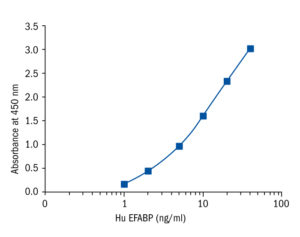Epidermal FABP (FABP5) Human ELISA
Human fatty acid binding protein EFABP is a 15 kD member of the intracellular fatty acid binding protein (FABP) family, which is known for the ability to bind fatty acids and related compounds ( bile acids or retinoids). in an internal cavity. The fatty acid binding proteins aP2 (fatty acid binding protein [FABP]-4) and mal1 (EFABP) are closely related and both are expressed in adipocytes. Absence of EFABP/mal1 resulted in increased systemic insulin sensitivity in two models of obesity and insulin resistance. Adipocytes isolated from mal1-deficient mice also exhibited enhanced insulin-stimulated glucose transport capacity. In contrast, mice expressing high levels of mal1 in adipose tissue display reduced systemic insulin sensitivity.
Features
- It is intended for research use only
- The total assay time is less than 3 hours
- The kit measures total EFABP in serum, plasma (EDTA, heparin), urine, and breast milk
- Assay format is 96 wells
- Standard is a recombinant protein
- Components of the kit are provided ready to use, concentrated or lyophilized
Research topic
Cardiovascular disease, Diabetology – Other Relevant Products, Energy metabolism and body weight regulation, Oncology
Type
Sandwich ELISA, Biotin-labelled antibody
Applications
Serum, Plasma-EDTA, Plasma-Heparin, Urine
Sample Requirements
Serum, Plasma, Breast milk: 25 µl/well
Urine: 50 µl/well
Storage/Expiration
Store the complete kit at 2–8°C. Under these conditions, the kit is stable until the expiration date (see label on the box).
Calibration Curve

Calibration Range
1–40 ng/ml
Limit of Detection
0.066 ng/ml
Intra-assay (Within-Run)
n = 8; CV = 5.8 %
Inter-assay (Run-to-Run)
n = 6; CV = 6.1 %
Spiking Recovery
96.1 %
Dilutation Linearity
97.9 %
– van der Leeuw J, Beulens JW, van Dieren S, Schalkwijk CG, Glatz JF, Hofker MH, Verschuren WM, Boer JM, van der Graaf Y, Visseren FL, Peelen LM, van der Schouw YT. Novel Biomarkers to Improve the Prediction of Cardiovascular Event Risk in Type 2 Diabetes Mellitus. J Am Heart Assoc. 2016;5 (6)

